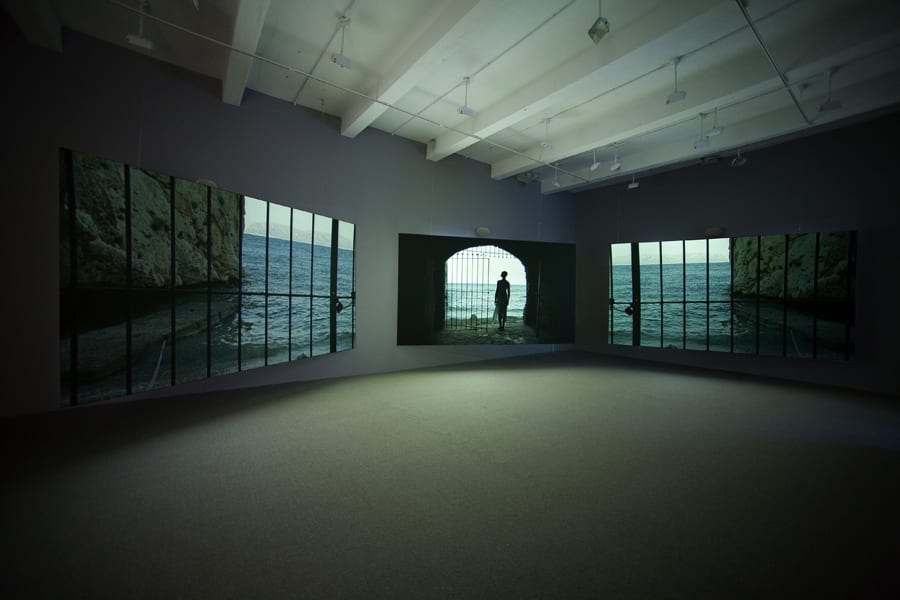Editor’s Note:
From the AJO Archives revisits past artists’ projects, conversations, interviews, and scholarly essays as part of our editorial work to place contemporary art practice in conversation with our archives.
We’ve paired the recent Contemporary Projects essay by Yelaine Rodriguez, “Children Of The Water,” in which the artist shares how a photographic series materialized from her own migration histories and relationship to water, with the critical review From the AJO Archives in which Emma Chubb discusses contemporary artworks addressing trans-Mediterranean crossings in “Small Boats, Slave Ship; or, Isaac Julien and the Beauty of Implied Catastrophe,” from May 5, 2016.
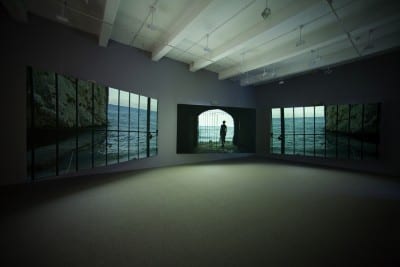
“How does one combine the artist’s pleasure in the act of creation with the horrific subject matter which is the source of the creation? And finally how does one guard against the spectator’s being struck primarily by the beauty of the work, lest he/[she] feel that an atrocity can be beautiful?” Yes, how?
—Ziva Amishai-Maisels and Marcus Wood
Three horizontal screens stretch across two gallery walls, suspended from the ceiling and hung in a slight arc. At first, the two flanking screens remain dark and only the center screen is illuminated. It shows an expanse of blue water, waves rippling with gold and reflecting the setting sun as they gently curl forward onto a barely visible beach. An archway and stone path frame this bit of sea and sky. Inside the archway, a metal gate, slightly ajar, fills the left half of the center screen, while the door to the right is fully open, its metal bars barely visible in the waning light. As the dark silhouette of a woman enters the frame, the left screen lights up. It too shows the sea and the setting sun from an almost identical camera position. The woman advances slowly and purposefully toward the open gate, her back to the viewer, before stopping just past the threshold. The light, gauzy fabric of her skirt sways around sculpted calves and thighs. The right screen illuminates and also shows the same framed doorway, as if to suggest that the viewer shares the space with this silhouetted woman, and as if she too, from a few paces back, takes in the glow of the setting sun and cresting waves.
These richly colored, carefully composed images continue over the next eighteen minutes and twenty-two seconds, immersing viewers in a world of saturated landscapes that rival guidebook photographs and luxury travel magazine covers. The sea reappears, its pristine blue water reflecting an equally blue sky. Small human figures walk across rippling, blindingly white cliffs, their bodies dwarfed by the enormous splendor of the sky, sea, and land. The interior spaces that appear next are equally lush and palatial; the manmade beauty rivals that of nature. A tile floor mosaic depicts exotic animals, green velvet swaddles footstools and beds, and gold covers everything, everywhere, from the ornately carved mirrors and furniture to the molding lining the ceiling and walls. In this baroque symbol of European aristocracy and luxurious excess, poised, muscular bodies slither and jerk up and down the stone staircases and writhe sensually on the tiled palace floor, their highly stylized movements mirroring those of the figures rendered in warm hues on the palace ceiling. Interrupting the movements of one person who—clad in army-green capri pants and a faded vest, with a wedding band clearly visible on his left hand—contracts and expands on the palace floor, are shots of the same figure, this time submerged under dark blue water. Filmed from multiple angles, his underwater movements mimic his aboveground twists and turns, while the sound of rushing water fills the gallery.
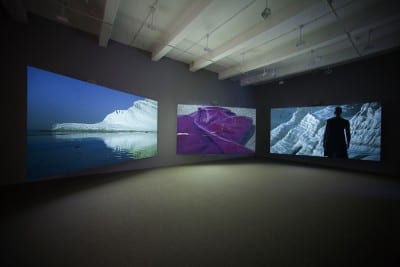
This “extravagantly beautiful filmmaking,” as the original gallery press release aptly describes it, is Isaac Julien’s Western Union: Small Boats (2007), which opened at Metro Pictures gallery in New York on October 25, 2007, and has since been exhibited in numerous solo and group exhibitions around the world.1 The film’s inviting seascapes, lush landscapes, arresting interiors, and sensual bodies surround viewers in the gallery and make it difficult to view the interspersed images of sculptural small-boat wreckages—the “small boats” of the work’s title—and the clandestine trans-Mediterranean migration they symbolize as anything more than an edgy backdrop for a Vogue or
The subject of Western Union—migration—aligns the film with the ever-increasing spate of artworks addressing clandestine trans-Mediterranean crossing, particularly in multichannel video- or film-based museum or gallery installations. Evidencing what I have elsewhere called contemporary art’s migratory turn, the south-to-north migration across the Mediterranean Sea has become an increasingly common subject for contemporary artists, critics, and curators.5 The small boats of migration, called pateras in Spanish and barques in French, have become, in the words of the art historian Jennifer González, “an iconic sign and key metaphor for African migration.”6 The subject of illegal sea crossings from Africa to Europe is frequently showcased in the same international art biennials in which Julien’s work appears, with artworks that focus predominantly on brown and black bodies anonymously traveling to Western Europe. To describe such contemporary illegal sea crossings, critics and curators often echo journalists writing about the topic and liken the journey to both the Middle Passage and the Holocaust, calling it a “new Middle Passage” and the “Sicilian Holocaust,” the latter a reference to the Italian island that serves as a destination for many migrants crossing from the Tunisian and Libyan coasts.7
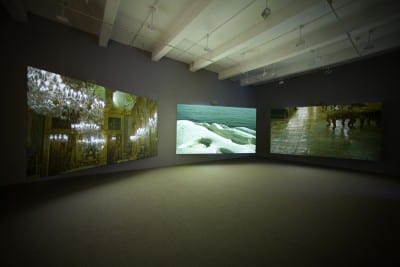
Unlike most migration-themed works, which employ an ethnographic or documentary approach often characterized by poor image and sound quality, Western Union is an exceedingly sleek work of the same high production quality as much of Julien’s recent oeuvre. In choosing this aesthetic approach, Julien sets himself apart from his peers and courts the danger of rendering beautiful the suffering, violence, exploitation, and, in many cases, deaths of contemporary migrants; he risks abstracting the migrants into sources of visual pleasure for an audience largely composed of the global, contemporary art biennial–visiting elite. The visual lushness of Western Union thus brings to the fore an urgent question about the representation of migration in contemporary art: to what extent does art reproduce exotic scenes of subjection, already so ubiquitous in European media outlets, for the pleasure of the art tourist and the cultural capital of the exhibiting museum, gallery, or organization?8
In this essay, I differentiate Julien’s work from both European media representations and the documentary and ethnographic approaches more commonly employed by artists addressing migration. To start is a short summary of the logistics and legislations of contemporary migration in which the focus is Italy, where Julien filmed Western Union. I then address the references made, largely in passing, to the Middle Passage in previous articles on Western Union. I do so in order to examine the relationship between representations of the colonial, transatlantic, legal, and forced migration of Africans to the Americas and that of the postcolonial, trans-Mediterranean, illegal, and ostensibly voluntary migration of Africans to Europe. What does bringing these two historically and geographically divergent crossings together illuminate about the ongoing legacy of transatlantic slavery, and what are the consequences for visual representation in the twenty-first century? How can artists represent migration without reducing the individual and the varied experiences of migrants to either the narrative of their abject suffering—the subject of much migration-themed art—or the fantasy of a European El Dorado? Playing on the two tropes of abject suffering and the El Dorado fantasy, which dominate representations of migration in both European media and the still largely Euro-American-centric contemporary art world, Western Union forces a reckoning with the entangled ethical, political, and aesthetic problems that this migration, like the Middle Passage before it, poses for artists and art historians alike.
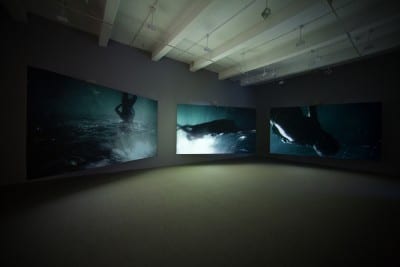
“Ugly facts in such beautiful ways”
In casting the migrant and the small boat as exotic figures in a sublime landscape and opting for gorgeous, stunning, and slow visual compositions rather than the documentary styles used in other migration-themed artworks, Western Union invites the criticism—one often raised by interviewers when speaking with Julien about his work—that the film minimizes and aestheticizes the violence of clandestine trans-Mediterranean migration.9 González summarizes this criticism in her compelling analysis of Western Union, asking, “Is it unethical to build a body of expensive, lush, and sensually gripping work around the real-life tragedies of immigrants? . . . To make something beautiful out of human relations that are truly ugly—how can this be a politically progressive gesture?”10 In his discussion of Western Union in a 2012 Museum of Modern Art catalogue, Julien responds directly to such criticism as it pertains to his treatment of migration. He writes, “I’ve been asked many times how I can represent such ugly facts in such beautiful ways. To me, the question isn’t why but why not? Why not apply the most aristocratic of styles to important stories?”11 With Western Union, he explicitly sought to eschew the dominant documentary approach when addressing migration: “The questions involved [with migration] are very, very serious, and the usual method of exploring them in film is through documentary, a genre that conveniently helps us to keep them separate from life. . . . The question becomes: why is it we want these images separated from us? Why do we feel more comfortable when they’re at a distance?”12 Julien’s partner and longtime collaborator, Mark Nash, meanwhile, sees the critiques of overaestheticization in Julien’s work as symptomatic of what he identifies as the curatorial trend of privileging of “a bare or severe aesthetic with intellectual rigor,” which he ascribes to “a formalist interpretation of modernism.”13
While the issues and responses these critiques elicit—the distancing versus empathy-generating effect of documentary, Julien’s invocation of the baroque, the persistence of formalist modernism—merit further debate, here, in the context of representing migration, it is important to highlight another danger of employing a “bare or severe aesthetic”: it risks affirming the clichés of victimhood and invasion that circulate regularly in media coverage of migration. The challenge of engaging without reiterating these clichés is a critical issue for Julien. Western Union explicitly references media representations of illegal migration in the European press, examples of which are reproduced in the catalogue from the 2009 exhibition of Western Union in Warsaw. As Julien recounts in a 2007 interview, he spent several years prior to filming collecting media images and interviewing survivors of the Mediterranean crossing.14 One of the film’s clearest engagements with the media occurs in its final minutes, when the camera captures close-up details followed by a long shot of six bodies draped in silver emergency blankets lying prone on an otherwise scenic beach where bathers wade in the background. In this scene, Julien reimagines the color photograph printed on page five of the English edition of the Spanish daily El País on May 6, 2006.15 Taken for Reuters by the photographer Juan Medina, the photograph shows a sandy beach at sunset.16 As the tide gently recedes, the lowering sun reflects off the water and the silhouettes of two small figures who stride along the water’s edge, as if taking an evening walk before the light disappears. This would be a pleasant, if unremarkable, photograph were it not for the body that fills the lower half of the frame. Tightly wrapped in a blanket identical to those draped over the bodies in Western Union, its head entirely covered, the shrouded body shimmers silver and blue in the waning light. Were it not for the toes peeking out from the blanket in the far right of the frame, the corpse would appear more fishlike than human. Shoeprints and tire tracks surround the body, presumably traces of whatever rescue effort arrived too late to save this individual.
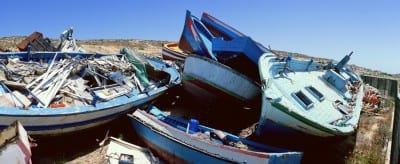
Additional newspaper pages reproduced in the Warsaw catalogue demonstrate the limited subject positions currently available for representing migrants according to the European mediascape. Some images conjure the suffering aboard the blue wooden boats, which are so overcrowded that passengers straddle the sides, their legs precariously hanging over the water. Others capture the suffering upon arrival: a sea of arms and hands, one missing a pinkie finger, all of them outstretched toward the distribution of food; a group of men backed against a wall, standing so close together that their shoulders graze one another, looking away to avoid the photographer’s gaze, with empty cans and other trash scattered around their bare feet. Then there are images that dramatize Europeans’ proximity and seeming indifference to such suffering, as epitomized by a photograph of a lone man, also taken by Medina. His skin, hair, hoodie, and jeans covered with a fine layer of white sand, he crawls on hands and knees across a beach under intense sunlight, while in the hazy distance, three corpulent figures sit plopped on towels, a perverse take on Édouard Manet’s Déjeuner sur l’herbe (1862–3), but sur sable.17
Julien’s appropriation and reimagining of these stereotypical media depictions of clandestine, trans-Mediterranean migration indicates an interest in effecting a broader shift in how migrants and migration are seen by the countries that receive them. As a result, his work participates in an expanding group of migration-themed artworks that focus on the many dangers of traveling from the so-called Global South to Western Europe over land and sea. Many of these works take the form of multiscreen video installations in a darkened gallery. Whether crossing the Sahara to reach the North African coast, as in Ursula Biemann’s video installation Sahara Chronicle (2006–7), or retracing a migrant’s passage on a map with a thick-tipped marker in Bouchra Khalili’s video series The Mapping Journey Project (2008–11), the migrant’s journey and, in particular, the small boats used in crossings are major themes in contemporary art across the globe.18 Works like Biemann’s and Khalili’s, which are characterized by handheld cameras, interviews with migrants, and minimal editing, mimic media reports in their emphasis on harrowing stories of crossings and the suffering of migrants during their journey. As I have argued elsewhere, what circulates in The Mapping Journey Project and other works that adopt a documentary approach and seek to make clandestine migration visible is the trope of the nonwhite, abject, suffering, desperate, and often dead or dying migrant body that, according to some, embodies the Italian philosopher Giorgio Agamben’s concept of “bare life.”19These works often neglect migrants’ agency and individual experiences. Equally absent is an engagement with how migration impacts social and economic life at home and what precedes and follows the journey.20
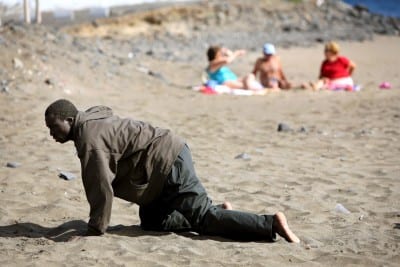
Although the same argument could be made about Western Union, whose brief flashback-like shots to a dry, cement-colored town arguably offer little by way of explanation for what provoked a journey that ostensibly ends in Sicily’s palatial interiors and on its sandy beaches, Julien nevertheless eschews equating African migrants and small boats with bare life by refusing to show the very real, representational violence inherent to any clandestine sea crossing. This refusal manifests most pointedly in Julien’s decision to enlist as performers the British actress Vanessa Myrie, who appears throughout Julien’s Expeditions trilogy, which includes True North, Fantôme Afrique (2005), and Western Union, and a group of professional dancers, whose sculptural bodies glide, thrash, and carry one another with controlled ease as they move across land and sea, reflecting their years of professional training. The difficulty the viewer experiences when trying to reconcile these bodies with the representation of migrants as abject in European media renders Julien’s reenactments transparent as performances. As González rightly notes, “The dancers look like dancers, not migrants, and they move with a casual poise more often seen on the stage than in everyday life. Their bodies are not starving, their bodies are not injured, they are not burned by the sun.”21 Julien’s Mediterranean and its inhabitants are far too beautiful and composed, too carefully choreographed and edited, too serene and sensuous to be confused with the documentary footage that dominates both media reports and the work of artists such as Biemann or Khalili, whose refugee- and migration-themed work was exhibited alongside Western Union in the Gwangju and Marrakech biennales in 2008 and 2009 respectively.22 The insistence on Western Union’s performativity and difference from most media and contemporary art representations of migration is important for two reasons. First, Western Union encourages viewers to consider not the fact of migration but rather the fictions and tropes that govern its representation. Second, it avoids the representational violence, which, in employing a “bare, severe aesthetic” to criticize the treatment of migrants, risks reinforcing the physical and racially inflected violence that targets migrant communities in, or headed to, Europe. Examples of how representational violence cannot be disentangled from its physical counterpart appear on both sides of the Mediterranean, whether in a Moroccan newspaper headline that refers to sub-Saharan migrants as “black locusts” invading the country, or in Italian legislation, discussed below, that defines illegal migrants as nonpersons.23
From the Middle White Sea to the Black Atlantic
Contemporary clandestine migration to Europe across al-baḥar al-abiyyaḍ al-mutawasiṭ, or the Middle White Sea as the Mediterranean is called in Arabic, saturates news coverage, political debates, and policy decisions on both sides of the sea, igniting fierce debates about national identity and human rights while also prompting comparisons to the Middle Passage of transatlantic slavery. Those hoping to enter the European Union from Africa typically travel overland to the North African coast and then attempt to cross by either sea or land. Migrants crossing by land travel to one of two heavily policed autonomous Spanish cities in northern Morocco, where they wait while living in dangerous makeshift camps near the border fences.24 Those who cross by sea, meanwhile, generally depart from coastal sites in Mauritania, Morocco, Tunisia, Libya, or Turkey.25 In 2008, a year after Western Union’s completion, the German magazine Der Spiegel reported the Vienna-based International Center on Migration Policy Development’s estimate that “100,000 to 120,000 migrants cross the Mediterranean by boat each year,” with “non-government organizations estimating as many as 1,000 deaths [while crossing] in 2007 and the United Nations High Commissioner for Refugees counting a more conservative 500.”26 These numbers have increased significantly since the so-called Arab Spring of 2011, due to ongoing wars in the region, which have decreased border security, facilitated smuggling, and caused a major upsurge in would-be migrants fleeing violence and traveling in larger, more crowded boats that, when they sink, result in more deaths. According to the United Nations, in 2015, over a million people arrived in Europe by sea, while in 2014 the number of displaced people worldwide, estimated at 59.5 million, reached the highest number recorded.27
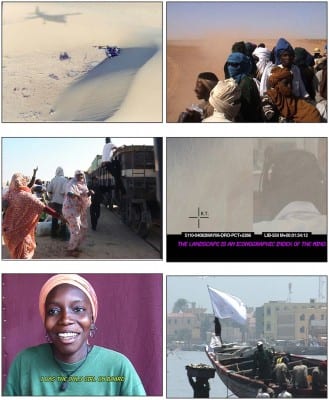
However migrants attempt to cross, the trip is expensive. The anthropologist Elie Goldschmidt notes that migrants coming from African countries south of the Sahara, where the average per capita income in 2008 was $762 per year, pay anywhere in the range of $5,000 to $35,000 for the entire journey.28 Once they reach the coast, the wait can last years.29 Throughout, they experience the traumatic psychological and physical effects of traveling overland from their home country to the continent’s northern edges.30 For those who survive the land and sea crossings, life does not dramatically improve on arrival in the European Union. The example of Italy, where Julien filmed Western Union, is instructive. According to the literary scholar Cristina Lombardi-Diop, Italy’s 1995 Dini Decree played a key role in enabling what she refers to as the country’s modern slavery because it legally defines illegal migrants as nonpersons. By adopting the decree, Italian legislation “established a double juridical system which, for the first time since the Italian Fascist regime, has created inequality between Italian and foreign citizens. The exclusion of certain categories of foreigners (illegali, clandestini, extracomunitari) from fundamental civil rights created the premises for their transformation from full persons into non-persons.”31 Lombardi-Diop calls the south-to-north Mediterranean Sea crossing a “new Middle Passage,” noting that both sea crossings are preceded by a common trans-Saharan route to Africa’s coasts, so today’s migrants often retrace the steps of enslaved Africans.32 was established by the Tuaregs for the trans-Saharan trade of commodities, including slaves, in the fifteenth and sixteenth centuries,” Ibid., 178, n20.]
A number of curators and scholars writing about Western Union also compare contemporary trans-Mediterranean migration with the Middle Passage. For example, Brady Roberts, who curated the Milwaukee exhibition of Julien’s Expeditions trilogy, writes, “The squalid journey of the migrants [in Western Union] . . . resonates back to the middle passage.”33 Similarly, the art historian Shelleen Greene describes the Mediterranean Sea in Western Union as “both a space of movement and a temporal locus that joins contemporary African migration to the trans-atlantic slave system.”34 Another link between these two crossings appears in Iain Chambers’s contribution to the Warsaw Western Union exhibition catalogue. Referring to Paul Gilroy’s seminal 1993 book, The Black Atlantic: Modernity and Double-Consciousness, he interprets the “contorted black bodies gasping in the foam, abandoned on the beach . . . or else writhing on the decadent palace floors” as “collating the Black Atlantic, memories of slavery and racialized oppression to the present-day Mediterranean.”35 Instead of expanding on the Middle Passage analogy, however, the majority of texts focus on Western Union’s engagement with other histories, geopolitical issues, or methodological challenges, whether that of Italian cinema and Julien’s dialogue with Luchino Visconti’s 1963 film Il Gattopardo (The Leopard), as put forward by Greene; Julien’s critique of globalization and inequality, highlighted by González; or the possibilities the installation offers for exploding the parameters of art history during its “global turn,” as the literary scholar Ranjana Khanna suggests.36
But what if we take seriously the proposed relationship between the Middle Passage and trans-Mediterranean migration, between slave ships and small boats, which thus far has appeared only to quickly disappear in the developing literature on Western Union? How might framing the visual representation of contemporary migration in the context of the Middle Passage and the Triangle Trade impact how we understand not only contemporary artworks about migration but also the relationship between the seemingly disparate eras and geographies of the Black Atlantic and the White Middle Sea? Of course, arguing for a parallel between the Middle Passage and the Mediterranean crossing raises serious problems. The Middle Passage was far longer than any geographic distance covered by today’s Mediterranean migrants over sea, and the slave ships were larger and bore little to no physical resemblance to the small boats of today’s clandestine migration. On board, the conditions were more gruesome and the power dynamics between inhumane crew and human cargo more acute and violent. Unlike contemporary migrants, who use cell phones and e-mail to stay in communication with family members back home, those who survived the Middle Passage had no hope of communicating with relatives living an ocean away. Additionally, to some extent, today’s migrants choose to make the journey—it is a service that they pay for, often with the financial assistance and blessing of their families—whereas the individuals forcibly shipped to the Americas were given no such choice. What’s more, correlating the two, as Chambers suggests Western Union does, could be seen as minimizing the horrors and erasing the particularities that defined both slavery in the Americas and the transatlantic slave ship crossings.
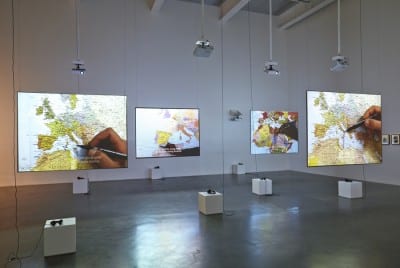
Here, it is helpful to return to Lombardi-Diop’s analysis of literary texts that explicitly refer to the Middle Passage to describe crossing the Mediterranean. Lombardi-Diop argues that for many African authors writing in Italian, contemporary migration “activates a parallel circulation of images and memories of the Atlantic Middle Passage,” often “in order to transform the experience of bondage into a promise of emancipation.”37 Among the texts Lombardi-Diop analyzes is Feven Abreha Tekle’s 2005 memoir Libera, in which the author, an Eritrean immigrant, writes that during her journey to Italy “I was reminded of having read somewhere that the slave ships of two centuries earlier that were used to transport African slaves to America were impregnated with a characteristic smell that was impossible to erase and which was felt at a distance of many miles. On that fishing boat it was the same thing.”38 memories of the Middle Passage,” activating what might best be described as a collective, transhistorical, and embodied memory-image of the slave ship crossings.39
Memory-images, as Siegfried Kracauer explains in his 1927 essay “Photography,” are distinct from photographic images because memory-images “retain what is given only insofar as it has significance. Since what is significant is not reducible to either merely spatial or merely temporal terms, memory-images are at odds with photographic [and historicist] representation.”40 Like the fragmentary and elision-filled account provided by Abreha Tekle, memory-images are characterized by opacity, in part because they appear to be random, due to retaining only what “has significance” for the individual to whose memory they belong. Abreha Tekle’s experience of her small-boat journey as akin to the Middle Passage also occurs by way of “rememory,” to adopt Toni Morrison’s term, lucidly summarized by the art historian Krista Thompson as “the ruptures in space and time and the ever-presentness of the past that are intrinsic to the memory of slavery and to the formation of the African diaspora more generally.”41 For Abreha Tekle, this rememory operates in a Proustian, synesthetic way; smell catalyzes the rememory, leading her to recall something she read presumably prior to beginning the journey north. Her experience of crossing also prompted a collective, embodied memory akin to what the poet and scholar Elizabeth Alexander describes in her seminal 1994 essay, “‘Can You Be BLACK and Look at This?: Reading the Rodney King Video(s).” Abreha Tekle’s written memory of her experience indicates a diasporic translation of what Alexander describes in the US context as the “traumatized collective historical memory which is reinvoked . . . at contemporary sites of conflict.”42
Whether we call it “memory-image,” “rememory,” or “traumatized collective historical memory,” Abreha Tekle’s likening her trans-Mediterranean crossing to the Middle Passage suggests that something more than literary metaphor is at stake in the claim that “on that fishing boat it was the same thing.” That Abreha Tekle and others make recourse to the literature of the Middle Passage raises an important question as to why migrants might find value in positing an equivalence between the Middle Passage and their Mediterranean crossing centuries later. Because Abreha Tekle’s reference to the Middle Passage occurs in a text intended to assert her personhood in a state—Italy—that legally refuses to recognize it, Lombardi-Diop compares the memoir and the other Italian language texts she analyzes to the slave narratives published in the United States during the nineteenth century.43 This comparison suggests that the rich African American literary and visual traditions may offer an effective model for contemporary migrants and their allies. On a political level, the canon of African American cultural production seems to provide a language through which today’s migrants can make the urgency of their demands for legal rights and material goods intelligible in Europe. Framing Europe’s treatment of illegal migrants in the language of the Middle Passage is a political shorthand that insists on the egregious violations of human rights. On an artistic level, it is easy to imagine the appeal: this is a canon filled with the stories of those who survived catastrophe and the memories and ghosts of those who did not. It is a canon that, to return to this essay’s epigraph, grapples with how to create something out of horrific subject matter; it is a canon that tells the story of modernity.44
Slave Ship, Small Boats, Afrotrope
How then—in the present context of analyzing Julien’s visual representation of contemporary migration—to explore the resonances between slave ships and small boats? How to understand the connection between these two seafaring vessels from different historical moments and of markedly divergent physical construction? The art historians Huey Copeland and Krista Thompson’s concept of the afrotrope offers one way to do so. As defined by Copeland and Thompson, afrotropes are “those visual forms that have emerged within and become central to the formation of African diasporic culture and identity in the modern era. . . . The afrotrope thus offers a vital heuristic through which to understand how visual motifs take on flesh over time and to reckon with what remains unknown or cast out of the visual field.”45 Copeland and Thompson’s concept of the afrotrope asks how and where certain images, including the now-iconic representation of the slave ship first published by the Society for Effecting the Abolition of the Slave Trade (SEAST) (1788; published 1789), appear and reappear across time and space in African diasporic cultural production, while also considering how these images change with each emergence. The moments and places at which an afrotrope (re)emerges—in what Copeland and Thompson have elsewhere discussed as “slavery’s perpetual returns”—raise crucial questions about how (a visualization of) the past continues to interrupt and affect the present, often in defiance of mapping techniques and historical narratives in which time and space adhere to certain linear conventions.46 Their concept of the afrotrope encourages not only analyzing how tropes for representing trans-Mediterranean migration have “take[n] on flesh” in recent years, as in the newspaper images discussed above, but also contextualizing these tropes within a much longer history of representing—in art and visual culture—black and brown bodies moving across space and sea.
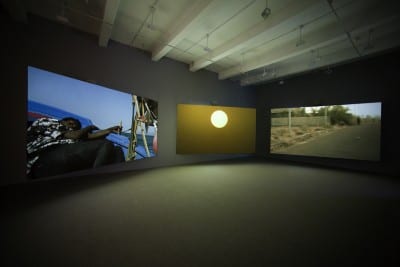
How does associating the Middle Passage with the Mediterranean crossing affect interpretations of Western Union, and how does it contribute to the broader discussions about representing migration in contemporary art? For González, Greene, and Khanna, the answer might be the themes of survival and witnessing, which each sees as a critical component of Western Union. Identifying Myrie as embodying these themes, the three scholars echo Julien’s description of the actress’s character as at once a witness, a reference to the mythical character of Adriana, and a stand-in for a female survivor whom Julien interviewed while preparing the work.47 Notwithstanding the danger of collapsing survival with witnessing, calling Myrie either a survivor or witness, or both, as in Greene’s hyphenated “survivor-witness,” suggests a viewing experience in which viewers project their thoughts onto those of the migrants or, as González suggests, one in which the viewer’s gaze merges with Myrie’s.48 gaze is our gaze [the viewers’], her witnessing is our witnessing.” González, 117.] This dissolution of the physical and psychological distinctions between the migrant, Myrie, and the viewer is instructive because it reveals a critical element of migration’s bad script and what I think is the key to Julien’s piece: the fantasy of El Dorado.
A mythological, gold-filled place that has its origins in European colonial fantasies about far-flung locales, El Dorado (The Golden One) dates to the sixteenth century, when the Spanish imagined first a gold-dusted king and then a gold-filled kingdom in the Americas. Over the centuries, El Dorado has become shorthand for a mythical place of great wealth.49 As trans-Mediterranean clandestine migration garners media and political attention in Europe, references to migrants naively seeking El Dorado in Europe have become de rigueur.50 In the present context of migration, the El Dorado fantasy’s European origin is effaced: it is migrants who are said to see and imagine Europe as brimming with gold. González’s otherwise excellent analysis of Western Union provides an example of how this El Dorado fantasy and its projection on the psychology of migrants subtend analyses of migration-themed contemporary art, including Western Union. For González, Julien’s film “addresse[s] the politics of migration from the psychological, internal state of the migrant” by depicting the phantasm of Europe as it is elaborately imagined by illegal immigrants sailing to Europe.51 Describing the shots inside the Palazzo Gangi in Sicily, she writes, “We grasp that we are now exploring the dreamscape of the migrating subject. The shimmering palace is the wished-for haven from hardship and strife, but also a mirage of luxury that is, finally, a site of refusal and unyielding power.”52 Despite González’s clear support of migrants’ rights, the suggestion here, however unintended, is that migrants dream naively and are dupes, believing in what the viewer or critic—González’s “we”—already knows to be merely a mirage: Europe as haven of leisure and luxury symbolized by the tanned, carefully coiffed members of a white elite who appear throughout Western Union, whether they are descendants of aristocracy or simply bourgeois enough to afford the leisure time of sunbathing on the Italian coast.
There are several problems with projecting onto the private thoughts of migrants and others who live in highly precarious legal, economic, and physical situations. In addition to maintaining an us-versus-them dichotomy between the knowing viewer or critic and the naive migrant, such projections risk, in the words of Saidiya Hartman writing in the context of US slavery, “exploit[ing] the vulnerability of the captive body as a vessel for the uses, thoughts, and feelings of others.”53 In the present context of illegal migration to Europe, these projections can have far-reaching, insidious consequences for determining who does and does not count as a person and whose freedoms the law protects, particularly amid the rise of extreme nationalism. Furthermore, casting the migrant as naive or foolish in his or her pursuit of Europe, even if inadvertently, contradicts the stories and cultural production of migrants themselves, which indicate that many undertake the journey with a much better understanding of what it entails than typically presumed.54 have become like / The 5,000 miles from Kinshasa to Brussels.” Quoted in Goldschmidt, 39.]
Rather than depicting the migrant’s “dreamscape,” as González suggests, Western Union visualizes a European fantasy of how African migrants imagine Europe. With its saturated colors and lush images, Western Union immerses viewers in a fantastical, excessive, yet wholly self-referential multiscreen mise en abyme of the colonial-era El Dorado fantasy, updated for the twenty-first century. In so doing, Julien’s film exposes the European paranoia and self-idealizing mythmaking that explains away clandestine migration as a foolhardy search for El Dorado to suggest that a fascinating displacement is currently under way. In it, the European desire for the temporally and geographically remote El Dorado of colonial yore, much like its desire for West Africa’s Gold Coast, has been replaced by a European desire for something much closer physically, if just as elusive: the vision of Europe as a paradise or Promised Land. This desire manifests in different ways, whether in the hope for continental unity, in rising nationalism and xenophobia, or, as Julien’s film proposes, in fantastical projections onto the psychology or dreamscapes of migrants. Hence the opulence, the sensuality, the sheer visual pleasure that Western Union both provides and undermines, its “dancers who look like dancers” gliding and thrusting their mesmerizing, muscular, nonmigrant bodies through the El Dorado–haunted dreamscapes not of migrants but of the film’s primarily European and North American viewers.
Inverting the now-standard aesthetic approach for representing migration in contemporary art while retaining all the trappings of its usual exhibited format—multiscreen digital projections installed in major art galleries, biennials, or museums across the globe—Western Union acts as an instructive foil. Not only does it illuminate the fantasies of Europe as a twenty-first-century El Dorado that undergird representations of migration, but it provokes a reframing of these representations within the longer history of imaging forced migration, from the Middle Passage to today. As Marcus Wood has argued, the two most famous representations of the Atlantic crossing—the 1788 SEAST engraving and J. M. W. Turner’s painting Slave Ship (Slavers Throwing Overboard the Dead and Dying, Typhoon Coming On) (1840)—suggest that a similar aesthetic debate about how to depict the Middle Passage took place in eighteenth- and nineteenth-century England. There is a parallel between the seeming realism of the SEAST print’s cool diagrammatic representation and the documentary approaches employed by many artists today, between Turner’s overworked surfaces and Julien’s fantastical screens. The latter works emphasize their status as aesthetic objects and, like all works that “describ[e] the atrocities committed by humans on humans,” “ha[ve] to embrace contradiction, and must try to make impossible combinations.”55 Wood convincingly shows how the abolitionists’ focus on representing the Middle Passage in visual and textual form hinged on two erasures, at once geographic and temporal: the before (in Africa) and the after (in the Americas). Today there is a similar focus on the immediate conditions of sea crossings, often to the exclusion of the broader social, political, and economic circumstances on both sides of the Mediterranean that propel migrants’ departure and receive them on arrival, which speaks to the ongoing problem in contemporary art and its institutions of how the so-called Global South is represented visually and art-historically. Grappling with this issue requires remaining ever attentive to the ways in which historical representations of black and brown subjects—such as those deployed in earlier representations of the Middle Passage in which “the black as cultural absentee, the black as a blank page for white guilt to inscribe, emerged as a necessary pre-condition for abolitionist polemic against the slave trade”—continue to limit how these subjects can and do appear today.56
Here, then, we come back to the afrotrope and the questions about how certain visual forms appear and reappear across time and space. Taking seriously claims about an equivalence between the Middle Passage and trans-Mediterranean crossing, between slave ships and small boats, raises the question—urgent to my mind for art historians concerned with both sides of the Atlantic—about how other tropes with origins in the “peculiar institution” of transatlantic slavery have traveled across time and space. Many of these tropes have resurfaced in the contemporary Mediterranean where, merging with longstanding primitivist and orientalist tropes, they gain traction.57 Like today’s migrants, these stereotypes do not simply travel to Western Europe. Among other places, they have also taken root in North Africa, the region through which migrants from across the continent, many of whom are black, frequently travel on their way to Europe.58
Bridging the slave ship and the small boat raises another question, this time methodological. It concerns the relationship of North Africa to the Black Atlantic, between “African Art (sub-Saharan)” and the “Art of Middle East/North Africa,” to use the College Art Association’s recently retired subject categories: is there space within the framework of the afrotrope, which Copeland and Thompson situate in the Black Atlantic, for the small boat, a visual trope that is largely sited in, originating from, and identified with North Africa?59 If so, linking the small boat to the slave ship troubles the elision of slavery with the specific institution of slavery in the Americas, which officially ended in 1888 with abolition in Brazil. Doing so brings into view contemporary forms of slavery—including that of many African migrants working in Eurozone countries—and its impact on subject formation on both sides of the Mediterranean. Just as important, this connection between small boats and slave ships places the entire African continent at the center of a dialogue between artists engaging the visual history and representation of two different yet overlapping sea-based diasporas. It pushes the boundaries of Africa and its diaspora beyond the false border of the Sahara to the landmass’s northernmost edges of Morocco, Algeria, Tunisia, Libya, and Egypt.60 Calling into question the divisions between North and sub-Saharan Africa highlights the ways in which this North/sub distinction is—like the afrotrope—a motif that has “take[n] on flesh over time” and whose “formal contours” and “significatory logic” must be undone.61
This, perhaps, is where Western Union leaves viewers: stranded in the artificial and lab-like space of the temperature- and humidity-controlled gallery, caught in the loop between screens, geographies, and times, staring at the beauty of implied catastrophe, with the challenge posed by this essay’s epigraph still unresolved: “‘How does one combine the artist’s pleasure in the act of creation with the horrific subject matter which is the source of the creation? And finally how does one guard against the spectator’s being struck primarily by the beauty of the work, lest he/[she] feel that an atrocity can be beautiful?’ Yes, how?”
The epigraph is from Marcus Wood, Blind Memory: Visual Representations of Slavery in England and America (Manchester: Manchester University Press, 2000), 68, in which Wood quotes the art historian Ziva Amishai-Maisels.
Part of the Afrotropes series.
Warm thanks to Hannah Feldman, for her ever-thoughtful advice, and to Huey Copeland and Krista Thompson, whose Northwestern University graduate seminar “Afrotropes,” and the many conversations that ensued, provided the initial impetus for this essay. The author is grateful for the comments and questions of Alison Boyd, Faye Gleisser, Nicholas Miller, and the anonymous reviewer for Art Journal; their careful engagement with this essay has much enriched it. Sincere thanks are also due to Isaac Julien, Ursula Biemann, and Benoit Pailley, who generously granted permission to reproduce images of their work, as well as to Michael Plunkett of Metro Pictures and Bernard Utudjian of Galerie Polaris for facilitating the process.
Emma Chubb is a presidential fellow and PhD candidate in art history at Northwestern University, where she is completing a dissertation on contemporary art in Morocco. Her work has been published in the Journal of Arabic Literature, caa.reviews, 10th Bamako Encounters, Nafas Art Magazine, and Art.es. In June 2014, she curated Mohssin Harraki: Graft, Trellis, Tame at L’appartement 22 in Rabat, Morocco.
- Metro Pictures, New York, “Isaac Julien, Western Union: Small Boats, October 25–November 17, 2007,” press release, 2007, rep. in The 7th Gwangju Biennale: Annual Report: A Year in Exhibitions, ed. Okwui Enwezor (Gwangju, South Korea: Gwangju Biennale Foundation, 2008), 104. To date, the work has been shown sixteen times in different iterations: three screens, five screens, single screen, and photographs. See Julien’s CV for the exhibition history at www.isaacjulien.com/about/cv, as of December 8, 2015. ↩
- Alan Gilbert notes the film’s fashion magazine–like quality in his review of the exhibition: “Isaac Julien: Metro Pictures,” Modern Painters 20, no. 1 (February 2008): 91. Gilbert is quoted in Jennifer A. González, “Sea Dreams: Isaac Julien’s Western Union: Small Boats,” in The Migrant’s Time: Rethinking Art History and Diaspora, ed. Saloni Mathur (Williamstown, MA: Sterling and Francine Clark Art Institute, 2011), 129 n. 14. ↩
- In the three-channel composite screening copy consulted for this text, the small-boat wreckages appear from minutes 1:45 to 3:45, and the boats and passengers appear from minutes 4:45 to 6:07, for a total of 3 minutes, 22 seconds that show the boats. ↩
- The literature on Julien’s work in film and installation is extensive. For overviews, see The Film Art of Isaac Julien, introduction by Amada Cruz, with essays by David Deitcher and David Frankel, exh. cat. (Annandale-on-Hudson, NY: Center for Curatorial Studies, 2000); Isaac Julien and Cynthia Rose, Isaac Julien: Riot, exh. cat. (New York: Museum of Modern Art, 2012); Kobena Mercer, and Chris Darke, Isaac Julien (London: Ellipsis, 2001); and Christine Van Assche, Isaac Julien (Paris: Centre Pompidou, 2005). ↩
- See my “Differential Treatment: Migration in the Work of Yto Barrada and Bouchra Khalili,” Journal of Arabic Literature 46, no. 2–3 (2015): 268–95. ↩
- González, 119. Here, González speaks specifically about the appearance of these boats in Spanish-language literature, but attention to migration in contemporary literature and cinema appears across Mediterranean languages. In addition to Manuel Martín-Rodríguez, “Mapping the Trans/Hispanic Atlantic: Nuyol, Miami, Tenerife, Tangier,” in Border Transits: Literature and Culture Across the Line, ed. Ana Maria Manzanas (Amsterdam and New York: Rodopi, 2007), 205–22, cited by González, see Katarzyna Pieprzak, “Bodies on the Beach: Youssef Elalamy and Moroccan Landscapes of the Clandestine,” in Land and Landscape in Francophone Literature: Remapping Uncertain Territories, ed. Magali Compan and Pieprzak (Newcastle-upon-Tyne, UK: Cambridge Scholars, 2007), 104–22, and Jonathan Smolin, “Burning the Past: Moroccan Cinema of Illegal Immigration,” South Central Review 28, no. 1 (Spring 2011): 74–89. ↩
- Although beyond the scope of this paper, the allusion to the Holocaust in the term “Sicilian Holocaust” bears further consideration. The Metro Pictures press release for Western UnionA uses the term “Sicilian Holocaust,” as does Shelleen Greene in “Envisioning Postcolonial Italy: Haile Gerima’s Adwa: An African Victory and Isaac Julien’s Western Union: Small Boats,” in Postcolonial Italy: Challenging National Homogeneity, ed. Cristina Lombardi-Diop and Caterina Romeo (New York: Palgrave Macmillan, 2012), 260. ↩
- “Scenes of subjection” is a reference to Saidiya Hartman’s work, both Scenes of Subjection: Terror, Slavery, and Self-Making in Nineteenth-Century America (New York: Oxford University Press, 1997), and “Venus in Two Acts,” Small Axe: A Caribbean Journal of Criticism 12, no. 2 (June 2008): 1–14. ↩
- Julien discusses beauty as it pertains to two works that predate Western Union—Looking for Langston (1989) and The Long Road to Mazatlán (1999)—in Áine O’Brien and Isaac Julien, “Suturing the Aesthetic and the Political—Multiple Screens, Multiple Realities: An Interview with Isaac Julien,” Circa 114 (Winter 2005): 49; and B. Ruby Rich and Isaac Julien, “The Long Road: Isaac Julien in Conversation with B. Ruby Rich,” Art Journal 61, no. 2 (Summer 2002): 63–64. ↩
- González, 127. ↩
- Julien, “Planet,” in Isaac Julien: Riot, 176. Julien’s decision to film in the eighteenth-century Italian Baroque Palazzo Gangi and his explicit claim to employ the “most aristocratic of styles” suggests an affinity between Western Union and the work of artists such as Kehinde Wiley and Luis Gispert, who also engage with the history of Baroque and Renaissance art. See Krista Thompson, Shine: The Visual Economy of Light in African Diasporic Aesthetic Practice (Durham, NC: Duke University Press, 2015), 215–70. ↩
- Julien, “Planet,” 174. ↩
- Mark Nash, “Reimagining Fanon,” in Isaac Julien: Riot, 132. For a brief discussion of early reviews of Looking for Langston that criticized the film for its beauty, see B. Ruby Rich, “In the Eyes of the Beholder,” Village Voice, January 28, 1992, 60. ↩
- Martina Kudláček, “Interview with Isaac Julien,” in Isaac Julien, Western Union: Small Boats, exh. cat. (Warsaw: Centrum Sztuki Współczesnej Zamek, 2009), 103. This interview was originally published in Bomb 101 (Fall 2007), at www.bombmagazine.org/article/2954/isaac-julien, as of December 8, 2015. ↩
- See Julien, Western Union: Small Boats, 72–78. ↩
- This photograph is reproduced on Medina’s Reuters profile at www.widerimage.reuters.com/photographer/juan-medina, as of December 8, 2015. ↩
- As Pieprzak notes, the drowned migrant
body washed ashore is a motif that appears in much migration-themed Moroccan literature. For these newspaper pages, culled from Libération (France), Rzeczpospolita (Poland), Gazeta Wyborcza (Poland), El País (Spain), and The Guardian (England), see pages 72–78 in the Warsaw catalogue. ↩ - Other artworks roughly contemporary to Western Union focused specifically on small-boat crossings into Western Europe include Adel Abdessemed, Hope (2011–12), Francis Alÿs, Don’t Cross the Bridge before You Get to the River (2008), Romuald Hazoumé, Dream (2007), Multiplicity, Solid Sea 01: The Ghost Ship (2001), and Catherine Poncin, Mourad ou l’épopeade sfigurata (2011–12). Migration by boat is also an important theme in contemporary art of the Caribbean. See, for example, Island Thresholds: Contemporary Art from the Caribbean, exh. cat. (Salem, MA: Peabody Essex Museum, 2005), and Jerry Philogene, “Visual Narratives of Cultural Memory and Diasporic Identity: Two Contemporary Haitian American Artists,” Small Axe: A Caribbean Journal of Criticism 8, no. 2 (September 2004): 84–99. ↩
- See Giorgio Agamben, Homo Sacer: Sovereign Power and Bare Life, trans. Daniel Heller-Roazen (1995; Stanford: Stanford University Press, 1998). ↩
- See T. J. Demos, The Migrant Image: The Art and Politics of Documentary during Global Crisis (Durham, NC: Duke University Press, 2013). Demos, an art historian, offers a useful definition of “bare life”—“life stripped of political identity and exposed to the state’s unmediated application of power” (xiv)—as well as a demonstration of its application to analyzing contemporary art representations of migration. In Chubb, “Differential Treatment,” I discuss in detail Demos’s treatment of migration, the prevalence of Agamben’s theory of “bare life,” and Khalili’s project along with the problems—and orientalist undertones—of advocating for ethnographic and documentary approaches as best practices for the representation of migration in contemporary art. ↩
- González, 123–24. González offers a more extended description and analysis of Western Union than is possible here. ↩
- In 2008, Western Union and Biemann’s X-Mission (2008), which focuses on a Palestinian refugee camp, were in the 7th Gwangju Biennale, curated by Okwui Enwezor, who also curated La Triennale in Paris in 2012, an exhibition that included Julien’s Territories (1984) and Khalili’s Speeches (2012). Similarly, Western Union and Khalili’s migration-themed Anya (Straight Stories—Part 2) (2009) were shown at the 2009 Arts in Marrakech biennial (now the Marrakech Biennale), curated by Abdellah Karroum. ↩
- On Morocco, see Elie Goldschmidt, “Storming the Fences: Morocco and Europe’s Anti-Migration Policy,” Middle East Report 36, no. 239 (Summer 2006): 36. On Italy, see Cristina Lombardi-Diop, “Ghosts of Memories, Spirits of Ancestors: Slavery, the Mediterranean, and the Atlantic,” in Recharting the Black Atlantic: Modern Cultures, Local Communities, Global Connections, ed. Annalisa Oboe and Anna Scacchi (New York: Routledge, 2008), 165. ↩
- For a general overview on this subject, see “Ceuta, Melilla Profile,” March 16, 2015, at www.bbc.co.uk/news/world-africa-14114627, as of December 8, 2015. See also “Illicit Crossings: Smuggling, Migration, Contraband,” a special issue of Middle East Report 41, no. 261 (Winter 2011). ↩
- From Mauritania, migrants attempt to reach the Spanish Canary Islands; from Morocco, they cross the Strait of Gibraltar to reach Spain; from Tunisia and Libya, they go to the Sicilian island of Lampedusa; and from Turkey, migrants travel to Greece. ↩
- “Africans Remembered: A Memorial for Europe,” Spiegel Online, June 17, 2008, at www.spiegel.de/international/europe/0,1518,560218,00.html, as of December 8, 2015. These death estimates seem very conservative. Consider, for example, that two hundred and fifty people drowned when a boat leaving Libya struck a reef on June 4, 2011. See Greg Feldman, “Europe’s Border Control with a Humanitarian Face,” Middle East Report 41, no. 261 (Winter 2011): 14. For Spanish government migration statistics, see Martín-Rodríguez, 213. ↩
- “Over One Million Sea Arrivals Reach Europe in 2015,” Office of the United Nations High Commissioner for Refugees, December 30, 2015, at www.unhcr.org/5683d0b56.html, as of January 5, 2016; “Worldwide Displacement Hits All-Time High as War and Persecution Increase,” Office of the United Nations High Commissioner for Refugees, June 18, 2015, at www.unhcr.org/558193896.html, as of January 5, 2016. See also Patrick Boehler and Sergio Peçanha, “The Global Refugee Crisis, Region by Region,” New York Times, June 8, 2015, updated August 26, 2015, at www.nytimes.com/interactive/2015/06/09/world/migrants-global-refugee-crisis-mediterranean-ukraine-syria-rohingya-malaysia-iraq.html?_r=0, as of December 8, 2015. Boehler and Peçanha cite “World Refugee Day: Global Forced Displacement Tops 50 Million for the First Time in Post–World War II Era,” Office of the United Nations High Commissioner for Refugees (UNHCR), June 20, 2014, at www.unhcr.org/53a155bc6.html, as of December 8, 2015. ↩
- Goldschmidt, 39. On the per capita income in sub-Saharan Africa, see C. W., “Standing Still but Going Backwards,” The Economist, January 21, 2014, at www.economist.com/blogs/freeexchange/2014/01/incomes-sub-saharan-africa, as of December 8, 2015. ↩
- Lombardi-Diop references the “days, even months” that migrants wait in Libya to cross to Italy via Lampedusa, 166. Those interviewed in Leila Kilani’s 2003 documentary Tanger, le rêve des bruleurs (Tangier, the Burners’ Dream), however, suggest even longer wait times. ↩
- For a description of the journey overland to the North African coast, see Goldschmidt, 39. ↩
- Lombardi-Diop, 165, where she draws on the work of the sociologist Alessandro Dal Lago. ↩
- Ibid., 174. In a footnote, Lombardi-Diop emphasizes the “geographical coincidence of ancient slave routes with modern migrant routes,” one of which passes “from Niger to Libya [and ↩
- Brady M. Roberts, “Expeditions: The Aesthetics of Post-Globality,” in Isaac Julien: Expeditions, exh. cat. (Milwaukee, WI: Milwaukee Art Museum, 2012), 26. ↩
- Greene, 259. Greene also contributed the essay, “Isaac Julien’s Expeditions Trilogy,” to the Milwaukee catalogue, which includes Roberts’s text and a reprint of González’s essay, 30–69. ↩
- Iain Chambers, in Western Union: Small Boats, 11. ↩
- González, 128; Greene, “Envisioning Postcolonial Italy,” 257–60; Ranjana Khanna, “Isaac Julien, or the Southern Question in Art History,” in Art History in the Wake of the Global Turn, ed. Jill H. Casid and Aruna D’Souza (Williamstown, MA: Sterling and Francine Clark Art Institute, 2014), 184. Greene and González are also interested in the work’s challenge to historical narratives, and they identify the multiscreen installation as rupturing linear approaches to history. While this argument is compelling, many migration-themed works are also multiscreen installations, and it could be said that the many screens multiply rather than subvert the myopic narrative of contemporary migration in which the migrant is always illegal, Europe-bound, and nonwhite. ↩
- Lombardi-Diop, 163 and 167. In moving directly from the Middle Passage to emancipation, these narratives could be said to erase slavery altogether. Thanks to Nicholas Miller for this insight. ↩
- Quoted in ibid., 166–67. Feven Abreha Tekle with Raffaele Masto, Libera: L’odissea di una donna eritrea in fuga dalla guerra (Milan: Sperling and Kupfer, 2005, in Italian).} For Abreha Tekle, who equates the two crossings using the transitive, past tense verb “was,” the trans-Mediterranean small-boat crossing “reawaken[s ↩
- Ibid., 166. ↩
- Siegfried Kracauer, “Photography (1927),” trans. Thomas Y. Levin, Critical Inquiry 19, no. 3 (Spring 1993): 425. ↩
- Krista Thompson, “The Evidence of Things Not Photographed: Slavery and Historical Memory in the British West Indies,” Representations 113, no. 1 (Winter 2011): 40. ↩
- Elizabeth Alexander, “‘Can you be BLACK and look at this?’: Reading the Rodney King Video(s),” in Black Male: Representations of Masculinity in Contemporary American Art, exh. cat. (New York: Whitney Museum of American Art, 1994), 93. ↩
- Lombardi-Diop, 170. ↩
- On the relationship between transatlantic slavery and modernity, see Paul Gilroy, The Black Atlantic: Modernity and Double Consciousness (Cambridge, MA: Harvard University Press, 1993). ↩
- Huey Copeland and Krista Thompson, “Afrotropes,” 2016 Call for Participation, College Art Association 104th Annual Conference, 6, at www.collegeart.org/pdf/2016CallforParticipation.pdf, as of December 8, 2015. ↩
- Huey Copeland and Krista Thompson, “Perpetual Returns: New World Slavery and the Matter of the Visual,” Representations 113, no. 1 (Winter 2011): 1–15. ↩
- For Khanna, Myrie’s Adriana is ambiguous, perhaps a witness, martyr, or the sea itself. See Greene, “Envisioning Postcolonial Italy,” 259; Khanna, 179. For Julien’s discussion of Adriana, see Kudláček, 101. ↩
- “Her [Myrie’s ↩
- For an overview of this history, see Fernando Ainsa, “The Myth, Marvel, and Adventure of El Dorado: Semantic Mutations of a Legend,” trans. J. Corbett, Diogenes 41, no. 164 (December 1993): 13–26; Shona N. Jackson, “‘God’s Golden City’: Myth, Paradox, and the Propter Nos,” in Creole Indigeneity: Between Myth and Nation in the Caribbean (Minneapolis: University of Minnesota Press, 2012), 111–44; John Silver, “The Myth of El Dorado,” History Workshop 34, no. 1 (Autumn 1992): 1–16. ↩
- Goldschmidt refers to El Dorado several times in his article. Meanwhile, books such as Eldorado or Fortress? Migration in Southern Europe reinforce the notion of Europe as El Dorado by neglecting to question or even explain this appellation beyond saying that “for ambitious migrants from poor countries Southern Europe is an eldorado where work, riches and a taste of the ‘sweet life’ may be obtained.” See Russell King, “Southern Europe in the Changing Global Map of Migration,” in Eldorado or Fortress? Migration in Southern Europe, ed. King, Gabriella Lazaridis, and Charalampos G. Tsardanides (Basingstoke, UK: Palgrave Macmillan, 2000), 19. ↩
- González, 127. ↩
- Ibid., 119. ↩
- Hartman, Scenes of Subjection, 19. ↩
- Consider the few lines from a song by the Congolese migrant El Pacha Docha that, according to Goldschmidt, migrants sing before they reach Europe: “The nine miles from Tangiers to Algeciras [Spain ↩
- Marcus Wood, Blind Memory: Visual Representations of Slavery in England and America (Manchester: Manchester University Press, 2000), 63. ↩
- Ibid., 23. ↩
- Italy, again, provides a pertinent example. See, for example, Sylvia Poggioli, “Italy’s First Black Minister Finds Herself a Target of Slurs,” All Things Considered, National Public Radio, August 13, 2013, at www.npr.org/sections/parallels/2013/08/13/211336128/italys-first-black-minister-finds-herself-a-target-of-slurs, as of December 8, 2015. ↩
- A number of Moroccan newspapers and magazines have covered racism and discrimination against sub-Saharan Africans in Morocco, including the French-language history magazine Zamane, which devoted much of its November 2013 issue to exploring the history behind contemporary racism. See “Aux origines du racisme au Maroc,” Zamane 36 (November 2013). ↩
- A task force of CAA members and staff revised the subject categories in 2014; the revision was adopted by the CAA board of directors, and then applied in 2015–16. ↩
- Each of these North African countries is a member of the African Union with the exception of Morocco, which left in 1984 due to the ongoing Western Sahara territorial dispute. For recent scholarly and visual-culture-oriented efforts to bring sub-Saharan and North Africa together, see the special “Africanity and North Africa” issue of Critical Interventions 3, no. 1 (2009), guest edited by Jessica Winegar and Katarzyna Pieprzak. ↩
- Copeland and Thompson, “Afrotropes,” 6. ↩

